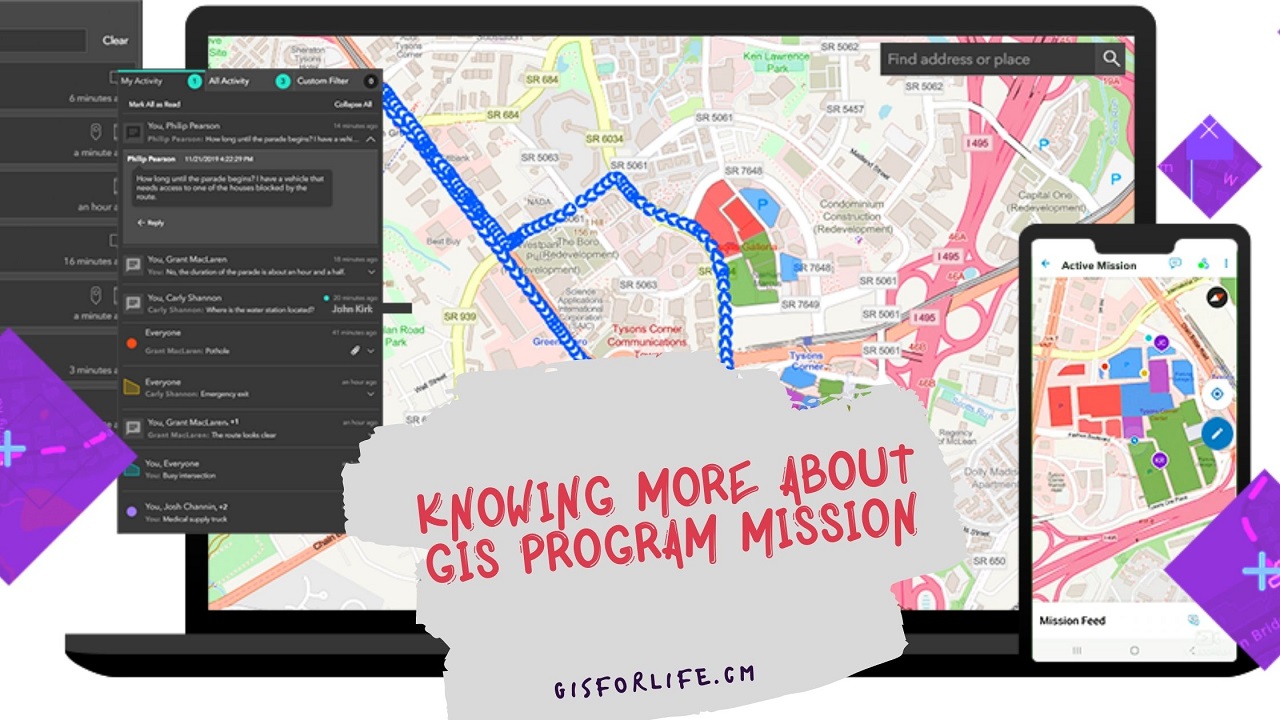Knowing More About Gis Program Mission

Geographic Information Systems (GIS) have been identified as an emerging industry by the US Bureau of Labor. GIS program uses computers, related hardware, people, and software to gather, manage, evaluate, and visualize spatial phenomena to help us understand and interact with the world around us better. Information Geographic Science (GIS) is an important synthesis of traditional mapping with advanced data modeling and analysis tools to provide new and expanded information on geographic topics.
Defining GIS Program Mission
The GIS Program Mission encapsulates the fundamental objectives and goals driving the implementation and utilization of Geographic Information Systems. It centers on leveraging spatial data to analyze, visualize, interpret, and understand patterns, relationships, and trends within geographical locations.
Advancing Knowledge and Decision-Making
At its core, the GIS Program Mission aims to facilitate informed decision-making processes by harnessing geospatial data. By integrating layers of information onto maps, this technology empowers businesses, government agencies, urban planners, and researchers to gain invaluable insights. These insights pave the way for strategic planning, resource allocation, risk assessment, and optimal utilization of resources.
Applications Across Diverse Sectors
Environmental Conservation and Management
GIS programs play a pivotal role in environmental conservation efforts. Through the analysis of environmental data, such as land use, biodiversity, and natural resources, these systems aid in formulating sustainable strategies for conservation and ecosystem management. From tracking wildlife habitats to monitoring deforestation, GIS technology contributes significantly to preserving our planet’s delicate ecosystems.
Urban Planning and Infrastructure Development
In urban settings, GIS applications assist city planners in developing efficient infrastructure layouts. By examining population distribution, traffic patterns, and land use, urban planners can design sustainable cities that prioritize accessibility, minimize congestion, and enhance the quality of life for residents.
Healthcare and Public Health
Within the realm of healthcare, GIS facilitates disease tracking, healthcare resource allocation, and epidemiological analysis. Mapping disease outbreaks and identifying high-risk areas enable proactive measures for disease prevention and resource allocation during public health emergencies.
Business and Market Analysis
Businesses leverage GIS programs to analyze market trends, consumer behavior, and spatial relationships. Location-based insights aid in site selection for retail stores, optimizing supply chain logistics, and targeted marketing strategies to reach specific demographics effectively.
Future Perspectives and Innovations
The GIS Program Mission continues to evolve with technological advancements. Emerging trends such as augmented reality (AR), artificial intelligence (AI), and the Internet of Things (IoT) are integrating with GIS, opening doors to more sophisticated applications and enhancing its capabilities across various industries.
Gis Program Mission
GIS Tech Notes describes the workflows and techniques used in geospatial science and technology research and extension. GIS is a specialty area that includes acquisition, mapping, programming, geographic intelligence, feature and image analysis, GIS, location and positioning, and related areas. It integrates hardware and software to capture, analyze, and present information in a way that the audience can understand.
Mission planning begins before you enter the field and integrates a range of logistical, technical, and safety factors. You will make better decisions if you bring knowledge of geography and spatial analysis to the table. These resources help you plan your fieldwork and use the best data.
Our research uses GIS technologies, including the use of spatial models, remote sensing, geographic information science (GIS), and computer mapping. The increasing ability to capture and process geospatial data means that spatial analysis is increasingly taking place in data-rich environments. The Geographical Information System (GIS) is the foundation of geo-information sciences, and advances in technology have a strong impact on spatial analysis.
The Department of Earth and Environment Sciences at Tulane University offers a Certification Program in GIS. The primary goal of the program is to ensure that students are anchored in GIS concepts and theories, including the organization, management, visualization of geodata, and collection and interpretation of remote data sets. The Geographical Institute offers a variety of courses in both GIS and Remote Sensing (RS).
The Bachelor of Geographic Information Science (GIS) is a new degree in one of the fastest-growing STEM fields in science and information technology. The degree is designed to improve knowledge of GIS for professional work in companies, public authorities, and non-profit organizations. Bachelor’s and post-baccalaureate certificates in (GIS) allow you to study computer mapping, spatial analysis, and spatial information technology and acquire valuable skills in the use of software such as ArcGIS.
The mission of the GIS Innovation Center is to coordinate, train, manage, and support the deployment, maintenance, and development of GIS technologies and geographic information systems across the country. The introduction of our master’s degree in Geographic Information Management is a direct response to increasing the value and use of Geographic Information Systems and to providing scarce resources to support and inform policy decisions.
The Bachelor of Science degree in Geographical Information Science (GI) provides the basis for a career in an emerging field that incorporates computer science, information technology, and geographical concepts and techniques to support the management and resilience of Earth’s natural, ecological, urban, and human systems.
Definition of areas of interest (AOI), maps, tactical resources, tasks, and common information for teams. Contribution, training, and support in the development and implementation of GIS technology in the country. Encourage teamwork between federal, state, and local authorities, the private sector, and educational institutions to address priority GIS and geographic information systems issues, as well as information development initiatives in the United States.
The New York State GIS Association supports, trains, coordinates, and manages the implementation, development, and maintenance of GIS technology in the state of New York. The Toolik Field Station GIS and Remote Sensing (TFS) GIS program facilitates and improves Arctic research by increasing research management, efficiency, and effectiveness of capabilities.
In July 2007, two GIS employees became part of the Type 3 Northwest Incident Management Team (NWIMT). This is the first Type 3 team in Washington State and the 20th in the United States. The experience of the Geographical Information Services (GIS) in the areas of public safety systems and natural disaster support has led to the department gaining a good reputation for the use of GIS tools to provide critical support services at events.
In 1992, the county began to recognize the limitations of the Autocad software and decided to buy ArcInfo GIS (Geographical Information Systems Software) from Esri. AutoCAD was used for cadastral mapping, but ArcInfo was a better tool to handle projects like the Washington Growth Management Act (GMA), which required complex spatial analysis. The district administration made a prudent business decision to separate the mapping center from the data processing department.
Google Earth pioneered 3D visualization and is a powerful tool to fly over an area from the comfort of your chair. It comes as a standalone application that you can download and go to the website and has many of the same features. OTM also supports tile services, so you can use Hillshade and other maps you create.
Read more: How To Create A Geographical Map
Critical thinking, ethical decision-making, and social justice are not only the core values of St. Joseph’s University but also a fundamental part of the professional community of GIS. GISCorps strengthens a wide range of Community spatial data infrastructures through the implementation of best GIS practices. Sources: 3, 12
Thank you to everyone who donated or bid at our silent auction to support GIS Pro 2019 in New Orleans. GISCorps implements URISA’s vision to promote the effective use of spatial information technology. We provide specialized GIS know-how to improve and develop transition communities without exploiting them for profit.
This work is supported by the USDA National Institute of Food and Agriculture Hatch Project 1015742 funded by the United States. This work is supported by the USDA-National Institute of Food and Agriculture Hatch Project. Sources: 15
A comma-separated list of the IP addresses of the clients that are allowed to access the ArcGIS server. This list is used as an additional security measure to prevent unauthorized access to the server.
This boolean indicates whether HTTP Strict Transport Security (HST) is used for HTTP. This boolean indicates whether a user with administrator privileges has access to the ArcGIS enterprise server on port 6080. If this is the case, the user has administrative access and is allowed to access the administrator directory of the server and the manager on that port.
Conclusion
In conclusion, understanding the GIS Program Mission is pivotal in harnessing the full potential of Geographic Information Systems. Its multifaceted applications across industries underscore its significance in enabling informed decision-making, resource optimization, and addressing complex spatial challenges.



